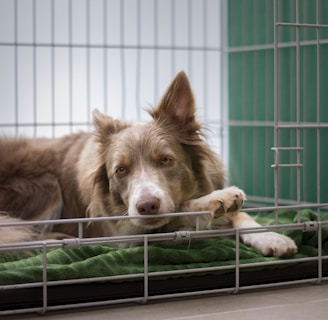The Comprehensive Guide to Crate Training: Benefits and Best Practices
DOG TRAINING
Chandler Hunt
4/8/20255 min read


Understanding the Benefits of Crate Training
Crate training offers a multitude of advantages for both dogs and their owners, serving as an effective method for managing a pet’s behavior while enhancing their comfort and security. One of the primary benefits is facilitating faster housebreaking. Dogs, being naturally clean animals, often instinctively refrain from soiling their sleeping area. By utilizing a crate, owners can help their pets develop a routine that reinforces this behavior, thereby expediting the housebreaking process.
Additionally, a crate provides dogs with a sense of security and comfort. It acts as a den-like environment where pets can retreat, relax, and feel safe. This is particularly beneficial for anxious dogs who may feel overwhelmed in unfamiliar surroundings. By encouraging their dogs to use the crate as a personal sanctuary, owners can foster a positive association with this space, ultimately promoting tranquility and reducing stress levels in various situations, such as during thunderstorms or fireworks.
Traveling with dogs can often result in anxiety for both the pet and the owner. Crate training equips dogs with the skills necessary to feel comfortable while confined to a vehicle or kennel. This can lead to a more enjoyable travel experience, as a well-adjusted dog is more likely to remain calm and settled throughout the journey. Moreover, a crate can serve as a vital tool in behavior management, providing a designated space for dogs when they need a timeout from stimulating environments or when guests are visiting. By creating boundaries, owners can guide their pets toward desirable behaviors, thereby minimizing issues such as jumping, barking, or destructive tendencies.
Incorporating crate training into your routine not only benefits dogs by providing a secure environment but also cultivates a more harmonious living situation for owners and their pets alike.
Introducing Your Dog to the Crate
Introducing your dog to a crate is a crucial step in crate training that can set the foundation for a successful experience. The process should commence with selecting the appropriate crate size. A well-fitted crate should allow your dog to stand, turn around, and lie down comfortably. It is essential to avoid a crate that is too large, as dogs may use one corner as a bathroom if they have ample space. When selecting a crate, consider materials such as plastic or wire, which offer different benefits for various dog temperaments and behaviors.
Once you have chosen a crate, make it a welcoming environment. Start by placing soft bedding inside, along with some of your dog’s favorite toys to create a cozy atmosphere. This space should be perceived as a safe haven rather than a confinement tool. Allow your dog to explore the crate at their own pace. You can enhance this experience by occasionally placing treats inside the crate, encouraging your dog to venture in voluntarily. This will help foster a positive association with the space.
Positive reinforcement is pivotal during this introductory phase. Use praise and rewards, such as treats or affection, whenever your dog enters the crate. This approach reinforces the behavior you want to encourage, establishing that the crate is a desirable place. Furthermore, maintaining a calm demeanor is vital; your dog is likely to mirror your emotional state. If you exhibit anxiety or frustration during your dog's initial interactions with the crate, it could hinder their acclimation process.
It is also important to allow your dog to adjust gradually. Start with short intervals of crate time, progressively extending the duration as they become more comfortable. Patience is key; every dog adjusts at their own pace, and a gentle introduction will help ensure a smooth transition to crate training. With the right approach, your dog will learn to love their crate as a personal retreat.
Creating a Successful Overnight Crate Training Schedule
Establishing an effective overnight crate training schedule is vital to help your dog adjust to their new sleeping arrangement. The first step is to determine the appropriate duration limits for crating. New puppies typically can hold their bladder for approximately one hour for every month of age. For instance, a three-month-old puppy should not be crated for more than three hours at a stretch. Adult dogs can generally hold it for longer periods, usually ranging from 6 to 8 hours. It is essential to recognize these limits to prevent accidents and ensure the dog's comfort.
Incorporating bathroom breaks into the schedule is crucial. Before bedtime, take your dog outside for a bathroom break to help them empty their bladder. When first starting the overnight crate training, plan to take them out during the night if they wake up or whine, as this may indicate they need to relieve themselves. Gradually, as they adjust, you can extend the time between bathroom breaks. During this phase, consistency is key; take your dog out at the same times each night to reinforce their routine.
Create a relaxing bedtime routine to signal to your dog that it is time to settle down. This could include turning off bright lights, using a calming voice, and providing a comfortable blanket or toy inside the crate. It is essential to allow your dog to feel secure in their crate by using positive reinforcement every time they enter voluntarily. If your dog begins to whine at night, it is important not to respond immediately, as this may reinforce the behavior. Instead, wait a few moments before checking in, as this will help them learn to settle down on their own.
Finally, when increasing crate time, do so gradually. Add increments of 10 to 15 minutes at a time, allowing your dog to adapt comfortably to longer durations. This careful approach to overnight crate training will foster a sense of security, ensuring your pet feels at ease during the night.
Addressing Common Challenges During Crate Training
Crate training can present a variety of challenges that may discourage pet owners from continuing with the process. Among the most common issues faced are whining, barking, and anxiety. Understanding the root causes of these behaviors is essential for developing effective strategies that can aid in overcoming them. Each dog is unique, and their responses to crate training can vary significantly based on factors such as temperament, age, and prior experiences with confinement.
Whining and barking are often responses to feelings of isolation or discomfort within the crate. It is crucial for owners to recognize that vocalizations can stem from genuine distress or, alternatively, a desire for attention. One strategy to mitigate excessive whining is to gradually desensitize the dog to the crate environment. This can be achieved by introducing the crate in positive settings, allowing the dog to explore it freely, and rewarding it with treats or praise when it enters willingly. This positive reinforcement encourages the dog to view the crate as a safe and welcoming space.
Environmental adjustments also play a significant role in successful crate training. Ensuring the crate is located in a part of the home where the dog can observe the household activities can help to ease feelings of loneliness. Additionally, providing adequate exercise before crate time can reduce excess energy, making it less likely for the dog to become restless. Engaging in physical activities such as walks, playtime, or training sessions can foster both mental and physical stimulation.
By implementing these strategies, dog owners can create a conducive environment for crate training, reducing the incidence of whining, barking, and anxiety. Emphasizing patience and consistency will assure a positive training experience for both the pet and owner, creating a well-adjusted and content canine companion.
TRAINING, BOARDING, DAYCARE
Trusted by busy dog owners across DFW to keep pets happy, healthy, and disciplined.
Services
Contact US
owner@sentinelk9.net
Call anytime: 682-615-6912
© 2025. All rights reserved.
